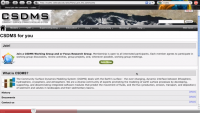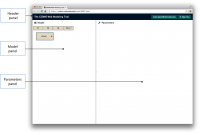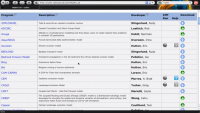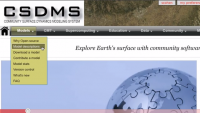CSDMS Organization
- What is CSDMS?
CSDMS stands for Community Surface Dynamics Modeling System. We are a diverse community of experts promoting the modeling of earth surface processes by developing, supporting, and disseminating integrated software modules that predict the erosion, transport, and deposition of sediment and solutes in landscapes and their sedimentary basins. Read more...
- Is there another effort like CSDMS?
Not quite, but there are many modeling efforts underway across the world, and we try to make connections and collaborate with other efforts when appropriate. CSDMS is willing to work together with the international community to build an integrated modeling community.
- Is CSDMS a Community Clastic Model?
No, it is a modeling community supporting a modeling architecture (not an "uber"-model). It deals with hydrology, nutrients, sediment (incl. carbonates), ecosystems, glaciers, oceanography, weather, etc. -- earth-surface dynamics. The goal of CSDMS protocols is to allow for models and components to be combined in unique ways to answer diverse questions. CSDMS is interested in stand-alone models, components and compliant contributions.
- How do I become a member of one of the Groups?
Simply follow the link and complete the form to join a working group and/or focus research group.
- I changed jobs. How do I inform CSDMS and the chairs of the various groups?
Please let us know if your contact information has been changed. Complete this form and we will update your contact information.
- How often do the Working Groups or Focus Research Groups meet?
Currently, each group hosts an annual meeting. The rest of their activity is done through remote communication systems.
- How do I benefit from becoming a member of CSDMS's Working Groups and or Focus Research Groups?
There are many ways you benefit. Most importantly, you become part of a family of experts who are willing to collaborate. You'll have an advantage in staying current within a community sharing research on the Earth Sciences. You'll also gain better knowledge on available models for education and application, and you'll have opportunities for interaction with a variety of industrial and NGO partners and federal agencies. Read more about this.
- Are there funding opportunities?
There are competitive funding opportunities through various traditional sources. Please note, CSDMS does not directly fund proposals, but association with CSDMS and detailing how your proposal can interact with and advance CSDMS can be helpful to your proposal. Benefits include:
- support by a state-of-the-art research agenda developed by an integrated community;
- support by a community of modelers & software engineers;
- access to a sophisticated modeling architecture, data systems, and high performance computing;
- CSDMS opportunities with NGO’s, agencies, and industry partners.
Model Contribution
- Why Open-Source?
Science is advanced through mutual cooperation. Community modeling involves the collective efforts of individuals that code, debug, test, document, run, and apply models and modeling frameworks. Community modeling relies on open-source code to address the practical need of contributing developers to examine and modify the code. Open-source code provides complete information transfer. This transparency is important because code is the ultimate statement of the scientific hypotheses embodied in a numerical model, and their implementation.
In the world of software, details are important. A scientific article describing code may provide the theoretical equations, but the solution to these equations can take numerous forms, and each solution has its pyramid of assumptions and limitations. Therefore open-source code allows for full peer review and replication of results — the foundation of modern science.
Open source code allows for reuse, often in new and clever ways. This certainly reduces redundancy. Open source does not mean that the original developer is not recognized. Developers are recognized with the metadata associated with each model, with GPL2 software license protection, through community exposure, vetting and recognition, and through accelerated citations within peer-reviewed publications.
In the world of science, software code is often considered “research grade”. That means that it is often relatively untested, may contain bugs, and might not be at the standards required for true “commercial grade” or “operational grade” code. Coding glitches in research grade code are often unknown by the original author. With wider community use, such problems are discovered and either rectified by the original author or by the bug discoverer. Research grade code should be widely available to the community of scientists through an appropriate international repository such as the CSDMS Model Repository.
Too often code is issued with an open source license but access to the code is restricted to access through the author. Unfortunately this allows the author to decide who they will give the code to. This runs contrary to the transparency needed in science, and we discourage this level of availability.
See also: Ince, D.C., Hatton, L., and Graham-Cumming, J. (2012) The case for open computer programs. Nature 482, 485-488. doi:10.1038/nature10836
- Where can I upload my model to make it available to the community?
First, complete the model questionnaire. CSDMS will create a special website for your model were you, yourself, can upload it, start a discussion page or create a page that explains some of the routines of your model. Have a look at one of the model pages currently hosted by CSDMS at our Models page.
- Why is CSDMS promoting the development of free open source code?
Since we’re working in the public domain, the general opinion is that the research should be public and community centered as well. One goal of CSDMS is to change the current culture, encouraging more open collaboration and cooperation as a community. Not long ago the climate community experienced such a cultural shift, which resulted in better funding and vastly improved, integrated modeling. Working together will make the earth-surface dynamics community more effective. There will be less duplication of effort, more ways to connect models, and these models will be open to be built upon.
- How are coders recognized?
- Through the CSDMS web site,
- with the metadata following the model,
- with GPL2 software license protection,
- through community exposure, vetting and recognition,
- through accelerated citations within CSDMS-supported peer-reviewed publications.
The CSDMS Integration Facility will insist on best practices to ensure that proper credit is provided by those who use CSDMS products, along with proper protection of, for example, contributions by graduate students. CSDMS has the advantage of following in the footsteps of the CCSM and CIG initiatives.
- I’m afraid to give my source code away. Can you ease my fears?
It’s ok to be a little apprehensive. It can be a bit intimidating to publish your code for all to see. Some things to remember: it is a way to advertise your code; your license will ensure that your name will stay with the code; most importantly, your model will be better for it because there will potentially be more people using it. You get credit for your work by making it public. Since you’re the most experienced user, you are probably also the best person to do a simulation. As more people learn about and use your model, there will likely be more opportunities to collaborate with you for proposals.
- How do I keep track of different versions of my model?
We encourage model owners to use some form of version control, like Subversion (SVN). If you are unable or just don’t want to host such a server, there are many other options. Perhaps the best solution is for model owners to create a SourceForge or Google Code project. These sites provide Subversion hosting as well as many other useful tools for managing a modeling project. If you don’t want to do this, CSDMS can also store your model in its subversion repository.
- Whoa there! I don’t want just anyone making changes to my model!
If you prefer, you can allow only a small group of people to have permission to make changes to your code. If someone makes an unwanted change, you can easily roll back to a previous version.
- What is my responsibility after submitting my model?
The owner of the model stays owner of their own model. CSDMS is providing the opportunity to store and make it available to the community. Once the code is available to the community, other people could, depending on your model license, add or change the code and create a new version if desired, but the original owner should always be recognized. By proving code, the owner is more or less responsible to answer possible questions that could arise or to fix bugs if that’s necessary. The nice thing about the CSDMS website is that other people may also answer questions or fix the bugs if they want. That's a major benefit of working with the greater modeling community.
- How can I make sure that I’m not overloaded with questions?
By making your model available on the CSDMS web site, other users can also answer questions or fix bugs; remember, this is a WIKI, any registered member can reply to questions on the model pages. Once a question is asked and answered on the model website, you needn’t answer it again and again.
- But if I give my model to the community, they’ll find bugs!
Not really a question. Yes, they probably will. This is a good thing. Sometimes you will be able to fix these bugs. Sometimes the community will fix them for you. Sometimes they will go unfixed. Users would rather a bug be identified and not fixed than not be identified in the first place. Don’t worry, users understand that you are busy and can’t get to every bug immediately (if at all).
HPCC: General
- How can I get an account on Beach?
Users wishing to get an account on the CSDMS cluster should follow these guidelines to request a one year guest account on our machine. Please note that account requests may take up to one week to process.
- Where should a new Beach user begin?
New users should read through the Technical Web pages that list guidelines for using Beach. In particular, new users should become familiar with VPN and ssh by means of the FAQ.
- Can I receive a letter of support from CSDMS when I apply for outside funding?
- How do I acknowledge CSDMS in my publications?
You can use our logo in talks. When reporting results that were obtained on the CSDMS cluster, we request that the following language be used as an acknowledgement:
- "We acknowledge computing time on the CU-CSDMS High-Performance Computing Cluster."
- Also, please notify us of any tech reports, conference papers, journal articles, theses, or dissertations which contain results which were obtained on beach. Your assistance will help to ensure that our online bibliography of results is as complete as possible. Citations should be sent to us.
HPCC: UNIX
- How do I change my password?
Use the secure web page, https://identikey.colorado.edu/ to change your password. This changes both your CU VPN password and your password on Beach.
- How do I change my shell?
Use the chsh command to change your shell (/bin/bash is a good choice).
HPCC: Access (SSH)
- What is SSH?
Secure Shell (SSH) is a program to log into another computer over a network, to execute commands in a remote machine, and to move files from one machine to another. It provides strong authentication and secure communications over insecure channels. SSH provides secure X connections and secure forwarding of arbitrary TCP connections.
- How can I upload or download files?
You must use a utility that uses the SSH protocol. Some option are sftp, scp, or rsync (make sure you specify ssh encryption with -e ssh). These utilities should be provided on most linux/unix platforms (including Max OS X).
- Where can I find other SSH clients?
Microsoft Windows users also have several choices for ssh client support, including:
HPCC: Batch Processing
- What is a batch request?
Batch processing on Beach is managed by the Torque in conjunction with the Maui scheduler. Torque batch requests (jobs) are shell scripts that contain the same set of commands that you enter interactively. These requests may also include options for the batch system that provide requests for resources such as CPU time, memory, and processors. For example submission scripts, see the Help section under the Supercomputing section.
- How do I submit, check the status, and/or delete a batch job?
Use qsub to submit, qstat to check the status of your job, and qdel to delete a batch request. For more information, see the online man pages.
- My job is writing output to TMPDIR, how can I look at it as it's being created?
First find out what node your job is running on by using the checkjob command and your job's IDThe node (or nodes) on which your job is running is listed under Allocated Nodes. Now that you know what node your job is running on, you can ssh to that node and have a look at your files,Your files will be under /data2/<jobid>.
EKT
- Can I address the NSF required broader impacts by using CSDMS EKT repository?
Yes, CSDMS can help with making your model project results available to geosciences, environmental sciences and engineering students and the general public by adding them to the EKT repository; simply as documented animations or as lectures or more elaborately designed classroom modeling excercises. There is no cookie-cutter way of doing as of now, but CSDMS EKT specialists will gladly work with you in the proposal phase. CSDMS can write a letter of support that elaborates on the plan.
- Can I use material from the CSDMS EKT repository in my classroom?
Yes, the material posted here is public-domain and is especially posted for educators at any level. We ask you to quote the original author or the CSDMS EKT repository.
- Can I use material from the CSDMS EKT repository in my documentary or museum?
Again yes, the material posted here is public-domain and for everyone to use. We ask you to quote the original author or the CSDMS EKT repository,for example by using the following language: "We acknowledge use of the CSDMS Educational Repository." Or use our logo. Also, please notify us of any documentaries, and journal articles which contain our material. Your assistance will help to ensure that our funding for putting these resources up will continue. Email us.
- Who are involved with EKT?
Irina Overeem is responsible for CSDMS Education and Knowledge Transfer, find her contact information. Many contributors are members of the EKT group.
|









